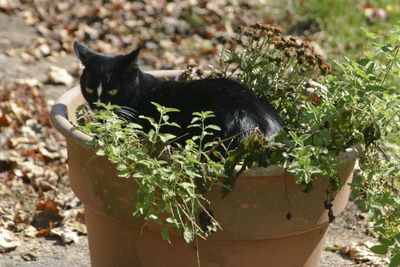Considerations on Catnip in Containers
Watching a feline roll in delight as it enjoys the potent oils of a catnip plant is always amusing. Cats seem to be disposed towards this member of the mint family and, fortunately for us, it grows like a weed and can be harvested and dried several times without complaint. In smaller gardens, potted catnip plants may be the only way your cat can have a consistent, fresh supply. Planting catnip in a pot is also attractive, with the notched, heart-shaped leaves and pretty spikes of purple-blue blooms. Catnip is a perennial herb and will come back year after year. In garden settings, it can be quite aggressive and take over areas where it is not wanted. Planting catnip in a pot not only prevents the plant from spreading but allows you to bring it indoors for kitties that cannot go outside. Place young plants away from kitty until they are large enough to withstand some serious loving. Cats will smell the plant from quite a distance, and your pets will show their affection to the herb in a variety of ways. Young plants simply can’t withstand such direct and intense interest.
Growing Potted Catnip Plants
Catnip needs well-draining soil, full sun, and average water. Indoor plants seem to require more sunlight than outdoor plants, which are relatively unfussy. The herb can get very tall and tends to be leggy in areas with low light. Provide plenty of light and pinch back young growth to prevent lanky stems that go every which way. Use a porous potting soil when planting catnip in a pot. You can also make your own with perlite, peat, and soil in equal amounts. Start catnip in flats initially and transplant them when they have two sets of true leaves. Plant seeds just under moistened soil and cover flats with plastic lids until germination. Keep flats in a bright, warm location. Mature plants will get a couple feet (61 cm.) tall without pinching and they have a wide root system. Use deep containers that allow for future growth once transplanting is necessary.
Catnip Container Care
Container grown catnip doesn’t have as many pest and disease issues as the herb outdoors. However, catnip is very sensitive to waterlogging and should only be watered when the surface of the soil seems dry, and then water deeply. Pinch young growth back to encourage a more shrub-like appearance. If flowers appear, snip these off to push more leafy growth. Feed once yearly in spring with a diluted indoor plant food. In summer, move the plant outdoors so it can enjoy more light. However, this can invite common pests of catnip such as whitefly, scale, aphids, and mealybugs – so keep this in mind. You can harvest catnip for your cat’s continued enjoyment. Dry the leaves and seal them in plastic bags in the freezer for fresh stuffing in your cat’s toys.
